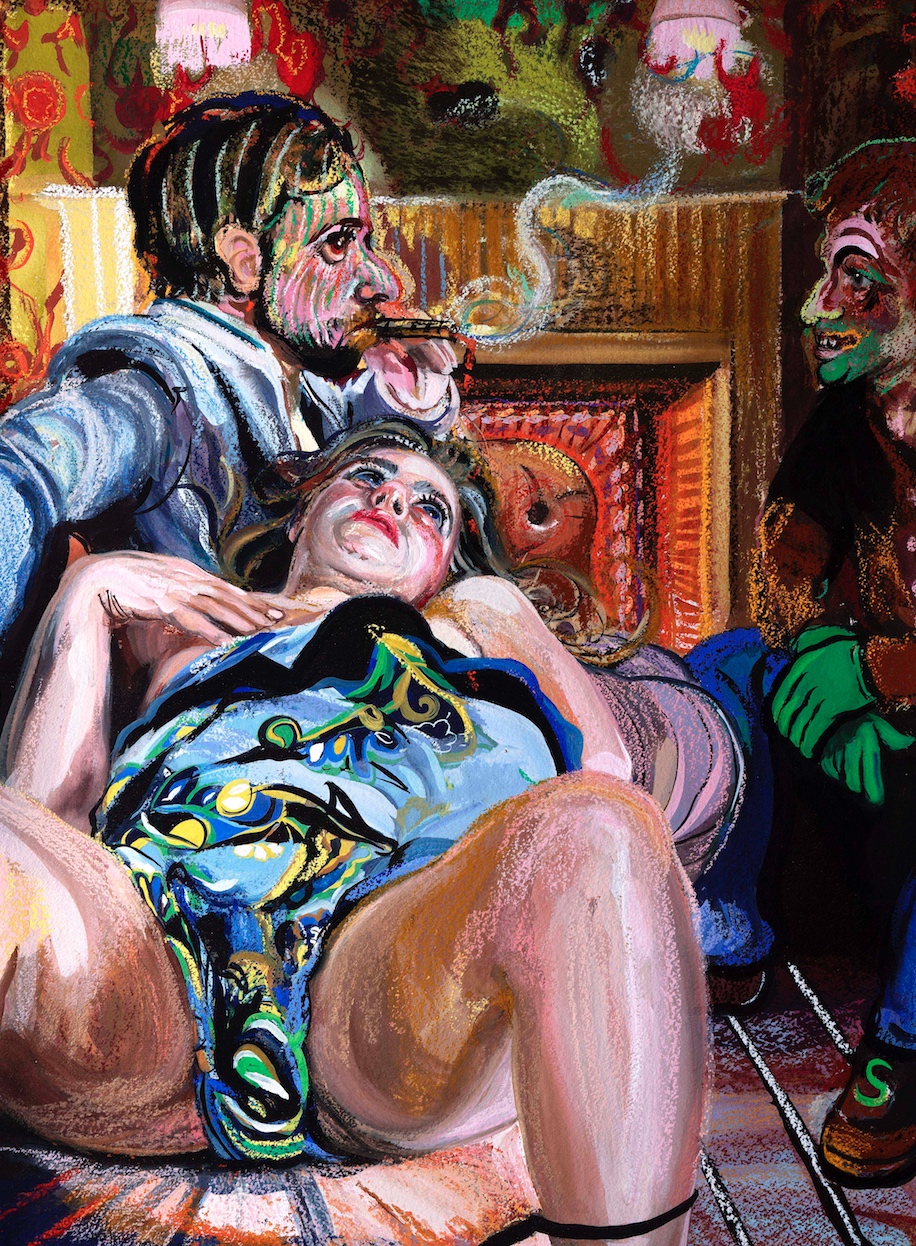Twisted portraits of sex, power and feminine desire
- Text by Ione Gamble
- Illustrations by Natalie Frank

“Women and all people want to see themselves represented, says Natalie Frank, a New York-based visual artist. “With greater freedom comes possibility.”
Using her art as a means to explore women’s stories concerning sex and power, she isn’t interested in neatly packaged, social media friendly or hashtag heavy feminism. Her work deals with the difficult: tackling the nuances of navigating the world as a woman through hyperreal figures, visceral colours, and a variety of mediums.
In her personal life, Frank practises what she preaches, and isn’t afraid to speak up against sexual harassment in the art world. So much so in fact, that her latest body of work O was rejected from an initial venue due to its subject matter.
Based on an erotic novel published in 1954 titled Story of O — in which its author Dominique Aury used a male pseudonym to publish the book, resulting in bold descriptions of bondage and desire which subsequently led to the banning of the novel — the initial gallery thought it “wasn’t a time to take risks with art”, and pulled out from exhibiting the works. Frank disagreed, and sought out curators who understand how critical conversations surrounding feminine desire, and power in the art world, are.

Story of O IV
“I have always thought of myself as a feminist,” Frank explains. “The narrative of O – of her finding her sexual and personal identity – has always embodied for me personal and erotic freedom.”
After first being drawn to the Story of O when she was 15 in a forbidden corner of a bookshop, this body of work — which includes an accompanying book providing context of the story through each feminist wave — is 33 years in the making.
“I find symmetry in the fact that this book was banned upon publication,” Frank says of the work’s relevance to our current socio-political climate. “Evidently, it and representations of it still threaten in 2018.”

Story of O VI
With the exhibition featuring 15 drawings and five mixed media paintings depicting key scenes from the novel, Frank’s interpretation proves Story of O deserves a more nuanced reaction than its reputation as a tool of pornographic oppression. It proves to be both a peek into the female erotic imagination, and relatable for those who choose to embrace their own desire as opposed to suppressing it. The work is equally liberating and uncomfortable, proving that sex-positive feminism needs to embrace the good, the bad, and the ugly of our lived experience in order to be successful.
“I’m a woman and am eager to see representations of desire be representative of lived experience,” Frank concludes. “I advocate for more nuance, complexity and power in our acknowledgement of what we allow women to think, feel, desire, covet, hate, possess and relinquish.”
“I believe in individual freedom as it applies to how we see our own gender, sexuality and rights. Our imaginations and our bodies are inextricably bound up in our personal freedom, and often represent it.”

Story of O XV

Story of O VIII

Story of O I
Natalia Frank’s Story Of O will be on display at Half Gallery (Bill Powers) from May 18. See more of her work on her official website.
Follow Ione Gamble on Twitter.
Enjoyed this article? Like Huck on Facebook or follow us on Twitter.
Latest on Huck

In the ’60s and ’70s, Greenwich Village was the musical heart of New York
Talkin’ Greenwich Village — Author David Browne’s new book takes readers into the neighbourhood’s creative heyday, where a generation of artists and poets including Bob Dylan, Billie Holliday and Dave Van Ronk cut their teeth.
Written by: Cyna Mirzai

How Labour Activism changed the landscape of post-war USA
American Job — A new exhibition revisits over 70 years of working class solidarity and struggle, its radical legacy, and the central role of photography throughout.
Written by: Miss Rosen

Analogue Appreciation: Emma-Jean Thackray
Weirdo — In an ever more digital, online world, we ask our favourite artists about their most cherished pieces of physical culture. Today, multi-instrumentalist and Brownswood affiliate Emma-Jean Thackray.
Written by: Emma-Jean Thackray

Meet the shop cats of Hong Kong’s Sheung Wan district
Feline good — Traditionally adopted to keep away rats from expensive produce, the feline guardians have become part of the central neighbourhood’s fabric. Erica’s online series captures the local celebrities.
Written by: Isaac Muk

How trans rights activism and sex workers’ solidarity emerged in the ’70s and ’80s
Shoulder to Shoulder — In this extract from writer Jake Hall’s new book, which deep dives into the history of queer activism and coalition, they explore how anti-TERF and anti-SWERF campaigning developed from the same cloth.
Written by: Jake Hall

A behind the scenes look at the atomic wedgie community
Stretched out — Benjamin Fredrickson’s new project and photobook ‘Wedgies’ queers a time-old bullying act by exploring its erotic, extreme potential.
Written by: Isaac Muk